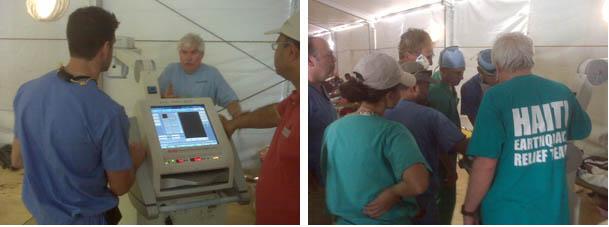
Jack Williams (center) and other volunteers help patients with Carestream technology.
February 2, 2010 - On Jan. 21, a C-130 aircraft piloted by the U.S. Air Force landed at the Port au Prince Airport in Haiti, 10 days after a devastating 7.0-magnitude earthquake ravaged the country. This particular flight carried volunteers — doctors, nurses, technicians, military personnel and humanitarians committed to providing assistance to the people of Haiti.
The flight also shipped a mobile X-ray solution, the ITX-560 manufactured by Carestream Health. The X-ray is suited for emergency situations, such as the one in Haiti, as a wireless, battery operated system that provides instant digital images. The company wanted to donate it, but had to find a way to get its service engineer, Carestream Health’s Jack Williams, and the equipment, on the ground. Fortunately, they received help from another Onex company, Emergency Medical Services Corp., a provider of emergency medical services in the United States. They put them in touch with Gregg Phillips, CEO at Autogov, who has a relationship with Project Medishare (projectmedishare.org), a nonprofit providing medical relief in Haiti. Phillips quickly jumped into action at the prospect of getting our technology to the front lines in Haiti.
Three days after the tragic quake, Carestream shipped the ITX-560 to Miami with the service engineer on stand-by all weekend waiting to leave. On Monday morning, Williams got the “all-clear” to travel to Miami where he met Phillips. As Williams explained, “Gregg deserves a lot of credit; he worked for two days straight trying to get us down to Haiti.” Phillips’ tenacious focus paid off with the military transport into Haiti.
Williams, who has traveled extensively in his 27 years with Kodak and Carestream Health, said, “This was by far the worst disaster I have seen. There were young babies, 90-year-old women, injured on cots.”
After arriving, Williams and Phillips were brought to a temporary hospital set up by Medishare. The ITX-560 was up and running by 7 a.m. the next morning and didn’t stop until midnight. Doctors were scarce so Williams and Phillips assisted patients with the help of a technician who fortunately spoke Creole. Fifty patients and 125 images later, they got some much-needed rest on cots lined up in rows under the tents.
Jack Williams and other volunteers help patients with Carestream technology
“The Haitians are tough people — they didn’t complain. It was beyond words what they were experiencing.” As day two began, more doctors were available; they gave Williams guidance on what images they wanted. From 7 a.m. to 1 a.m . they worked side-by-side to accommodate the mounting backlog of people. In some cases, the injured had been waiting over a week to be seen. New patients arrived by the hour. When it was time for Williams to return on Sunday, a radiologist from Tennessee just happened to arrive. Operation of the ITX-560 was quickly transitioned so they could continue to help those in need.
Williams noted, “This was the most worthwhile cause of my life, and it felt good at the end of the day. But, I just happened to be in the right place at the right time.”
There are estimates on the staggering numbers: 200,000 people dead, 194,000 injured and 1.5 million people homeless. There is a story behind every number. Although these figures are overwhelming, Jack Williams and his Autogov partner were able to help play a part in turning a catastrophic event into a story of compassion.
In closing, if you’d like to help, you can make a donation to the American Red Cross for the relief efforts. Carestream will match each dollar and direct the funds to long-term, rebuilding efforts. The logistics are provided at the end of this message.
Mail your check to:
Carestream Health Inc.
150 Verona Street
Rochester, NY 14608
ATTN: Karen Sharrow (MC: 01120)
